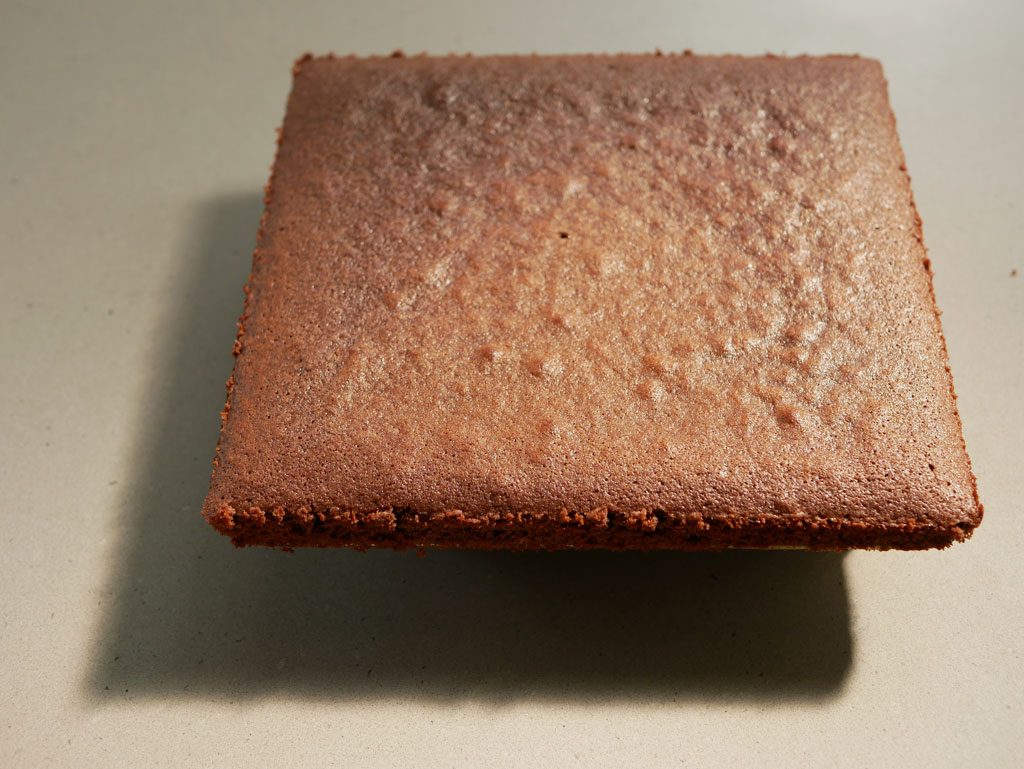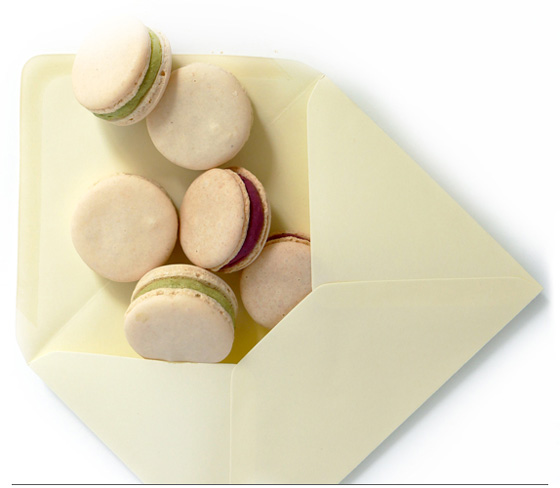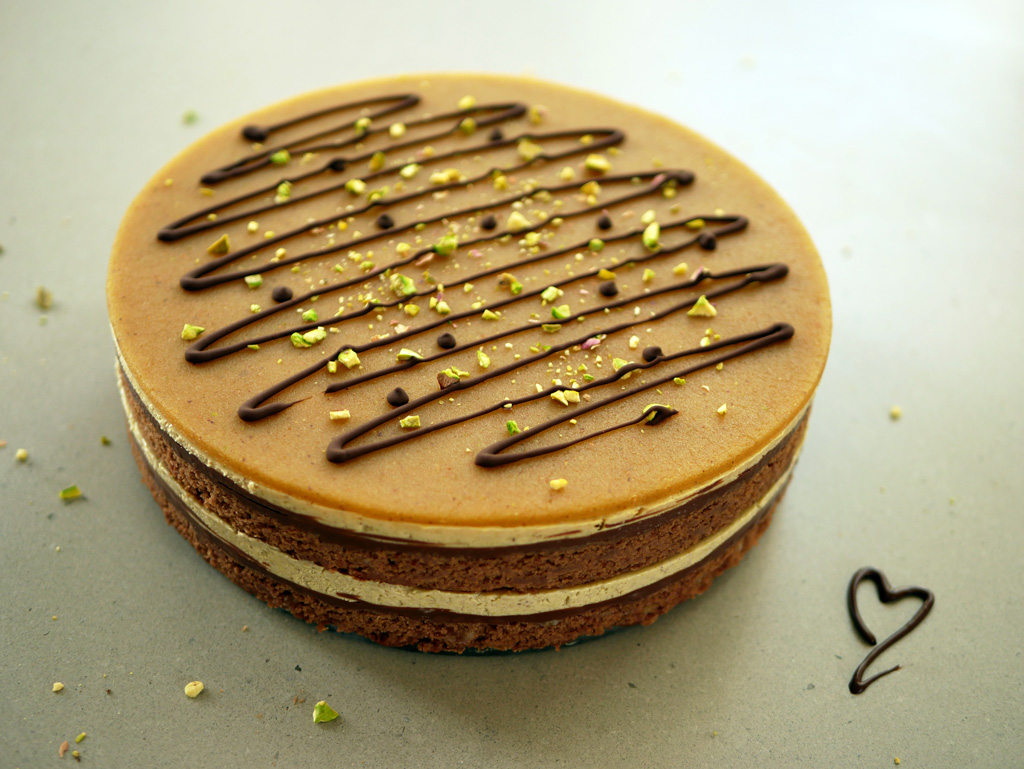Mozartkugel Cake
Not long ago, a couple of my dear sweet friends challenged me to recreate a candy almost as sweet as them, the Mozartkugel. The candy contains pistachio marzipan at its core, covered in a layer of nougat and then coated with a layer of dark chocolate. The MozartKugel was first created in the city of Salzburg in Austria. It brought a lot of good to the world, but also some major legal disputes over its name.
To avoid any weird European conflicts, I decided to recreate the candy in the form of a cake, rich with marzipan. Seriously now, this cake is a delicacy for all marzipan lovers. There’s 500 g of marzipan in the cake. Half a kilo!
In the end, the cake went to celebrate my little sister’s birthday (Happy Birthday Rana!). Unlike the Mozartkugel candy, the only conflict we had at the party was which nephew will get the bigger slice of the cake.
…
The Mozartkugel cake contains two layers of pain de Gênes (a soft sponge cake with a distinctive marzipan taste), two layers of praliné cream (hazelnut nougat with dark chocolate) and two layers of pistachio ganache. I decided to expose the hidden pistachio marzipan core of the candy and present it on top of the cake as the final layer.
It’s more efficient to prepare the two layers of pain de Gênes in two pans at the same time. However, if you only have just one pan (as did I), you will have to divide the recipe by two and just bake it twice. As for the cream and the ganache, I also divided the recipe by two and prepared each layer separately when the time came to add it to the cake. In any case, the recipe for the Mozartkugel cake is written in such a way that you don’t have to do each layer separately, like I did.






Ingredients for Mozartkugel cake
Chocolate pain de Gênes
300 g marzipan
135 g sugar
290 g eggs
10 g milk
95 g flour
3 g (¾ tsp) baking powder
80 g dark chocolate
95 g butter
Praliné cream (nougat)
200 g hazelnut praliné
100 g dark chocolate
Pistachio paste
100 g shelled pistachios
17 g grape seed oil
Pistachio ganache
400 g white chocolate
80 g pistachio paste
260 g heavy cream
Coating
200 g marzipan
20 g pistachio paste
A bit of powdered sugar
Decoration
50 g dark chocolate
5 g of chopped pistachio
Equipment
One or two square pans, 24×24 cm
A round ring, diameter of 22 cm & height of at least 6 cm
8-10 cm acetate strip
Chocolate pain de Gênes
Lightly grease the square pans with oil. Line the bottom of the pans with parchment paper. Preheat oven to 175º C (350º F).
Melt chocolate and butter on a double boiler and keep aside. Mix marzipan with sugar in a food processor. Transfer the marzipan mixture into the mixer bowl and mix on medium speed using the paddle attachment. Add eggs gradually. Replace paddle attachment with the whisk attachment and whip for about 3-4 minutes on high speed. Add milk and mix. (This whole process can be prepared in just a food processor, but mine is too small for the job, so I had to use the mixer as well).
Fold flour and baking powder into the batter. Finally, add the melted chocolate and butter and mix just until uniform. Divide the batter in two equal amounts using a scale. Pour the batter equally into each pan and flatten the surface with a spatula. Place the pans in the oven and bake for about 10 minutes. Stick a toothpick in the center of the cake to check if it’s ready. The toothpick should come out dry.
Remove pans from the oven. Separate the cakes from the sides of the pan using a serrated knife. Let the cakes cool completely at room temperature before cutting. (It’s even better to let the cakes sit for half an hour to an hour in the freezer to obtain a cleaner, sharper cut).
Place the round ring on top of one of the cakes and press on it to cut a round layer of cake. Clean the ring and cut another round layer from the second cake. Set one of the cakes on a serving plate. Wrap the acetate strip around the cake and set the ring around it. Keep both layers in the freezer.
Praliné cream (nougat)
Melt the chocolate on a double boiler. Remove from heat and add the hazelnut Praliné. Mix until uniform. Divide the cream into two equal parts.
Remove the cake with the ring around it from the freezer. Spread one part of the Praliné cream on top of the pain de Gênes layer. Flatten the cream with a spatula or a spoon. Put it back in the freezer to let the Praliné cream set (it takes about 10 minutes). Cover the second part of the Praliné cream in plastic wrap and keep aside.
Pistachio paste
Preheat the oven to 160 °C (320 ºF). Scatter the pistachios on a baking tray and roast for about 7 minutes until they brown a bit. After the pistachios have cooled, grind them to a powder in a small food processor. Add the oil and grind again until it becomes a paste. Weigh the amount needed and store in the fridge until use.
Pistachio ganache
Break the chocolate into small pieces and put them in a measuring pitcher. Add pistachio paste to the pitcher as well. Bring the heavy cream to a boil and pour over chocolate, making sure all the chocolate is covered. Mix a little bit with a spatula and then use a hand blender to blend it to a uniform consistency. Divide the ganache into two equal parts.
Remove the cake with the ring around it from the freezer. Pour one part of the ganache on top of the Praliné cream that has probably set by now. Tilt the cake so that the ganache spreads all over the top or just flatten the surface with a spatula. Put back in the freezer to let the ganache set (about half an hour). Cover the second part of the ganache in plastic wrap and keep aside.
Putting the rest of it together!
Remove the cake with the ring around it from the freezer. Remove the second layer of pain de Gênes from the freezer as well. Place it (carefully) on top of the ganache layer inside the ring.
Fetch the second part of the Praliné cream and make sure it’s still soft (if not, soften it a little on a double boiler). Spread the Praliné cream on the second pain de Gênes layer. Flatten the surface with a spatula or a spoon. Put it back in the freezer to let the Praliné cream set (about 10 minutes).
Fetch the second part of the pistachio ganache and make sure it’s still soft (if not, soften it a little on a double boiler). Pour the ganache on top of the Praliné cream. Tilt the cake so that the ganache spreads all over the top or just flatten the surface with a spatula. Put it back in the freezer to let the ganache set (at least half an hour).
Coating
Cut the marzipan into cubes and put in it the mixer bowl. Using the paddle attachment, mix until the marzipan softens a little. Add pistachio paste and mix until uniform.
Sprinkle a bit of powdered sugar on a clean surface. Transfer the mixture to the surface. Roll out the mixture with a rolling pin to a 3 mm thickness. Keep turning the mixture throughout and make sure it doesn’t stick to the surface. (Close to the end, it’s much easier to just roll it on a parchment paper).
Remove the cake from the freezer. Release the ring from the cake. Use the ring to cut out a round layer from the rolled marzipan. Lift the layer of marzipan and place it (carefully) on top of the ganache layer. Flatten the surface if needed.
Peel off the acetate strip form around the cake, but only after the cake had completely set in the freezer and the ganache is stiff enough to keep its shape during the process.
Decoration
Sprinkle chopped pistachios on top of the cake. Melt chocolate on a double boiler. Fill a pastry bag with the melted chocolate. Cut a small opening at the end (about 3-4 mm). Pipe the chocolate in thin lines over the top of the cake.
The Mozartkugel cake keeps for about two to three days at room temperature in an airtight container (or even for a week in the fridge, but it’s recommended to let it sit at room temperature for at least an hour before serving). Mozartkugel, over.

Tags In
Related Posts
8 Comments
Leave a reply:Cancel reply

Search the blog
![]()
Get updates by email













Hi, lovely recipe! I would like to make small bars with this recipe? Could i use a squared pan (so i have less waste?)?
Thank you!
Yes, you can do it all in a 19-20 cm square pan and then slice into smaller bars.
Great! I tried it yesterday. I halved the recipe because i wanted to make a smaller batch. Everything was perfect, except for the pistache ganache. This was a bit runny, even after cooling it for more than 30 min. Will try a little less cream next time. Do you have another suggestions for this? Thank you for the wonderful recipe! I will definitely use this more often.
Oh, glad to hear! Though I’m sorry about the ganache. I wonder if you’re pistachio paste was a bit runnier than mine. In any case, yes, try lowering the amount of cream next time and it will do the trick. I would try with very small portions first until you get the perfect consistency.
Your recipe looks AMAZING and I would love to try it. I’m a big fan of Mozart Kugeln and this looks heavenly. I have a question about the cake though. Are the cake layers moist? Its a sponge cake and you didn’t moisten it with anything, so I’m wondering if its dry.
Thanks!
Oh thanks!
Nope, I didn’t moisten the cake layers. However, they’re not really dry. They’re kind of soft and tender and worked well enough for me with the addition of the cream layers. I would suggest you do a test before assembling the layers. After you bake and cut the cake, taste the leftovers and see if it’s too dry for you or not. If indeed dry, moisten it as you like (coffee syrup might actually work nicely here).
Love Mozartkugeln ! This is beautiful way to make a huge quantity of this tasty dessert ! Thank you ! Pinned !
Hehe, I agree! The more, the better ?